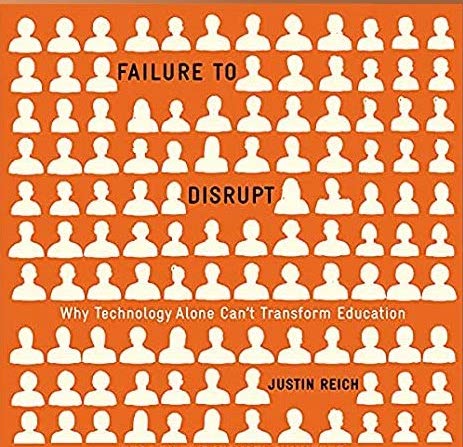
 Failure to Disrupt: Why Technology Alone Can’t Transform Education is a well-written critical synthesis of overzealous claims and unrealistic attempts to revolutionize education through technology. Its author, Justin Reich, is an Assistant Professor in the Comparative Media Studies department at the Massachusetts Institute of Technology (MIT) where he studies future learning. He is also the creator of several publications and EdX courses on education as well as the designer of online courses for teacher education (which he offers a critique of in the current work). His writing here, while critical of the field’s progress, is also inspiring with down-to-earth realism that gives the reader access to a balanced evaluation of technology’s impact on education.
Failure to Disrupt: Why Technology Alone Can’t Transform Education is a well-written critical synthesis of overzealous claims and unrealistic attempts to revolutionize education through technology. Its author, Justin Reich, is an Assistant Professor in the Comparative Media Studies department at the Massachusetts Institute of Technology (MIT) where he studies future learning. He is also the creator of several publications and EdX courses on education as well as the designer of online courses for teacher education (which he offers a critique of in the current work). His writing here, while critical of the field’s progress, is also inspiring with down-to-earth realism that gives the reader access to a balanced evaluation of technology’s impact on education.
The previous decades have been loaded with unfulfilled promises offered by technology. Fears that teachers would be replaced by computers were ultimately unrealized but too was the dream of a radical improvement and the democratization of a suffering education system. Bombarded by every innovation and the pandemic, the teacher and administrator could be forgiven for not seeing through the weeds of their own learning management systems. The claims have been loud, but the practice has become habitual and administrative without time or cognitive space for critical evaluation (although we have all had the best of intentions). Training new teachers on technology and standardizing systems have become the practices of everyday teaching. There is a lot out there, but no clear way to sort through it. This book is a nice place to catch up and get back in the game.
There is no doubt that this book is critical of aspects of the education-via-technology revolution, but Reich is not ranting against the use of technology. He instead grounds evaluation in research, breaking his insights into several themes. Schools, teachers, and society will often use new technologies not to innovate and transform ways of educating but instead they become new playgrounds for old practices. Current systems exhibit a strong gravity to maintain practices, and new technologies can become just another way to duplicate previous methods pulling along for the ride both what works and what doesn’t. Regarding computer-assisted instruction and assessment, we have found that these still are most effective at routine learning and highly formalized technical knowledge. They do not yet effectively tackle the development of communicative competence, critical thinking, abstract thinking, and reasoning. Furthermore, the promise of equity has not been borne out so far by the technology. It seems to be that those with greater access use the technology more frequently and more efficaciously than those who have been traditionally neglected by the system; as Reich argues, educational technology may widen already existing gaps. And finally, the promise of big data insights that have been so useful in other sciences has been severely limited by privacy laws and restrictions on student experimentation. The author dissuades us of the notion offered by the sales reps that the technology will be the magic pill of education. However, while these claims appear pessimistic, there is much more to this text than deconstructing the ed-tech industry.
Through engaging the book, the reader develops a better understanding of the larger ecology of instructional technologies. Reich arms the reader with systems of thinking and methods of evaluation that empower readers to be informed consumers of existing and emerging computer-aided instruction. Through this evaluation, Reich also makes the reader aware of their own practices in existing frameworks. I found myself rethinking what I was using technology for in the courses I teach but also learned about many other systems that were out there. What others are doing well, and how I could capitalize on their learnings to broaden my own impact. The reader can use this book similarly to tinker around the edges and discover what might work well for their content-specific learning goals while being aware of the potential caveats, persistent pitfalls, and opportunities while integrating technology in instruction.
One of Reich’s main points is that learning technologies are not wholly new. They are new forms of previous technologies and ways of thinking. We can also learn about current technologies by looking back at their historic forms and the theory that the new forms are built upon. This is also probably true of the field of education, often new theorists and practitioners repackage previous ideas and their successes or failures are somewhat predictable based on previous iterations. Reich’s assessment of emerging systems helps unify this history and our ongoing missions in education.




